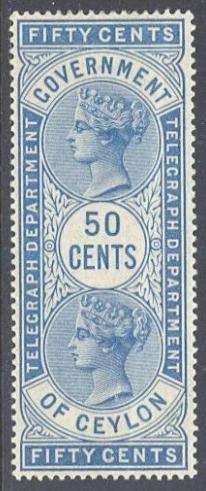Steve Hiscocks
Dr. Steve E.R. Hiscocks (died 4 October 2010[1]) was an expert on telephone and telegraph stamps who in 1982 wrote the first catalogue on the subject since Walter Morley's work of 1900. He also wrote the first ever catalogue of telephone cards (1988) and the first catalogue of telegraph seals (2007).

An 1894 telegraph stamp of Ceylon.
Outside collecting, Hiscocks was a civil servant in the Department of Energy of the British Government.[2]
Publications
- Telegraph & Telephone Stamps of the World: A priced and annotated catalogue, Woking, 1982. ISBN 0-9508301-0-0
- The Collector's Book of Telephone Cards, Woking, 1988. ISBN 0-9508301-1-9
- The Collector's Book of Telephone Cards, 2nd revised edition, Stanley Gibbons, London, 1990. ISBN 0-85259-264-7
- Collect British and Irish Telephone Cards, Stanley Gibbons, London, 1991. ISBN 0-85259-307-4
- Telephone Cards of the World: Great Britain and Ireland Pt. 1, 1993. ISBN 1-898344-00-0
- Telephone Cards of the World: North America, Caribbean and Atlantic Pt. 2, World Telephone Card Publications, 1994. ISBN 1-898344-01-9
- H & G Standard Catalogue of USA Telephone Cards: Including Canada: 1995-1996, 2nd edition, Telecard Publications Inc., 1995. (With C.M. Garibaldi) ISBN 0-9648605-0-3
- Telephone Cards: A Collector's Handbook, Woking, 1996. ISBN 0-9508301-2-7
- Telegraph Seals: A World Catalogue, Woking, 2007. ISBN 0-9508301-3-5
gollark: ```For instance, say I want a wooden chest: I've got several solutions: - Use an existing chest- Craft a chest from existing planks - Craft planks and then craft a chest Now, normally I'd say the first is the best. But what happens if I've only got 1 dark oak chests, and I've got 1000 oak planks. Surely it'd be better to create a chest from the planks in this case, as it results in a more balanced system.```Mentioned by the people on the CC discord I asked.
gollark: And no good way to tell which one is "best".
gollark: Well, there are multiple patterns for most items, see.
gollark: How to generate the list of crafting tasks and their order.
gollark: That bit is easy.
References
- The Philatelic Exporter, November 2010, p.33.
- "Calling collect - Collecting" by Robin Young in The Times, 15 February 1992.
External links
This article is issued from Wikipedia. The text is licensed under Creative Commons - Attribution - Sharealike. Additional terms may apply for the media files.